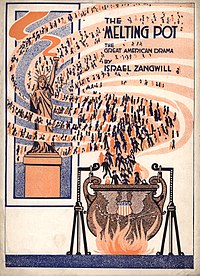
Back قدر صهر Arabic اریتمه قازانی AZB Gresol de cultures Catalan مەنجەڵی توانەوە CKB Melting pot Czech Tawddlestr Welsh Schmelztiegel German Fandopoto Esperanto Crisol de culturas Spanish دیگ ذوب Persian

A melting pot is a monocultural metaphor for a heterogeneous society becoming more homogeneous, the different elements "melting together" with a common culture; an alternative being a homogeneous society becoming more heterogeneous through the influx of foreign elements with different cultural backgrounds. It can also create a harmonious hybridized society known as cultural amalgamation. In the United States, the term is often used to describe the cultural integration of immigrants to the country.[1] A related concept has been defined as "cultural additivity."[2]
The melting-together metaphor was in use by the 1780s.[3][4] The exact term "melting pot" came into general usage in the United States after it was used as a metaphor describing a fusion of nationalities, cultures and ethnicities in Israel Zangwill's 1908 play of the same name.
The desirability of assimilation and the melting pot model has been rejected by proponents of multiculturalism,[5][6] who have suggested alternative metaphors to describe the current American society, such as a salad bowl, or kaleidoscope, in which different cultures mix, but remain distinct in some aspects.[7][8][9] The melting pot continues to be used as an assimilation model in vernacular and political discourse along with more inclusive models of assimilation in the academic debates on identity, adaptation and integration of immigrants into various political, social and economic spheres.[10]
- ^ United States Bureau of the Census (1995). Celebrating our nation's diversity: a teaching supplement for grades K–12. U.S. Dept. of Commerce, Economics and Statistics Administration, Bureau of the Census. pp. 1–. Retrieved 27 November 2012.
- ^ Vuong, Quan-Hoang (2018). "Cultural additivity: behavioural insights from the interaction of Confucianism, Buddhism and Taoism in folktales". Palgrave Communications. 4 (1): 143. doi:10.1057/s41599-018-0189-2. S2CID 54444540.
- ^ p. 50 See "..whether assimilation ought to be seen as an egalitarian or hegemonic process, ...two viewpoints are represented by the melting-pot and Anglo-conformity models, respectively" Jason J. McDonald (2007). American Ethnic History: Themes and Perspectives. Edinburgh University Press. pp. 50–. ISBN 978-0748616343. Retrieved 27 November 2012.
- ^ Larry A. Samovar; Richard E. Porter; Edwin R. McDaniel (2011). Intercultural Communication: A Reader. Cengage Learning. pp. 97–. ISBN 978-0495898313. Retrieved 27 November 2012.
- ^ Joachim Von Meien (2007). The Multiculturalism vs. Integration Debate in Great Britain. GRIN Verlag. ISBN 978-3638766470. Retrieved 27 November 2012.
- ^ Eva Kolb (2009). The Evolution of New York City's Multiculturalism: Melting Pot or Salad Bowl: Immigrants in New York from the 19th Century Until the End of the Gilded Age. BoD – Books on Demand. ISBN 978-3837093032. Retrieved 27 November 2012.
- ^ Lawrence H. Fuchs (1990). The American Kaleidoscope: Race, Ethnicity, and the Civic Culture. Wesleyan University Press. pp. 276–. ISBN 978-0819562500. Retrieved 27 November 2012.
- ^ Tamar Jacoby (2004). Reinventing The Melting Pot: The New Immigrants And What It Means To Be American. Basic Books. ISBN 978-0465036356. Retrieved 27 November 2012.
- ^ Jason J. McDonald (2007). American Ethnic History: Themes and Perspectives. ISBN 978-0813542270
- ^ Caves, R. W. (2004). Encyclopedia of the City. Routledge. p. 457. ISBN 9780415252256.